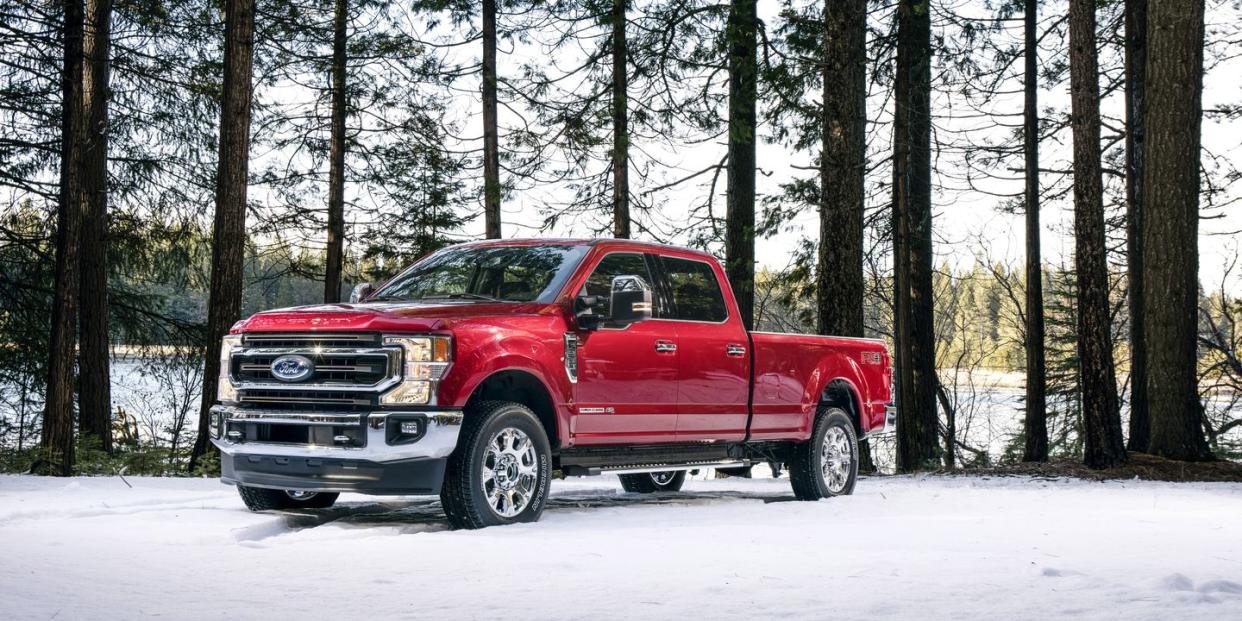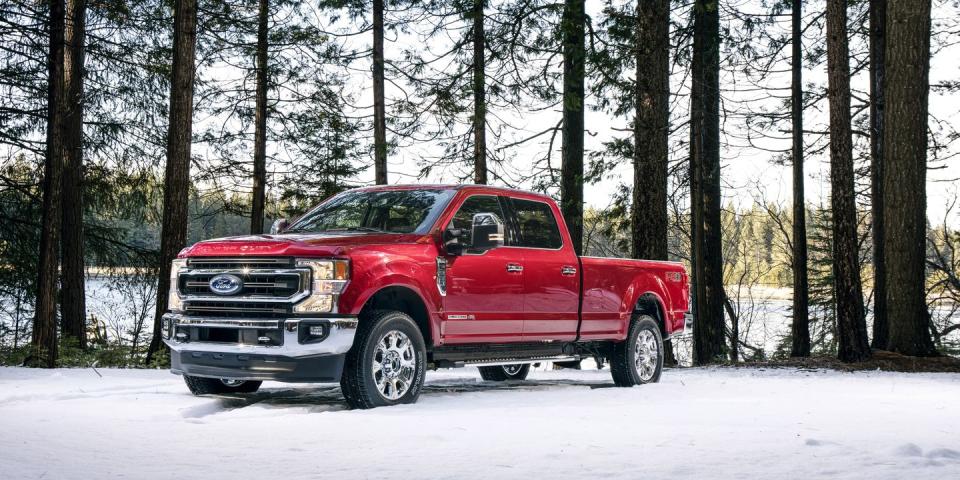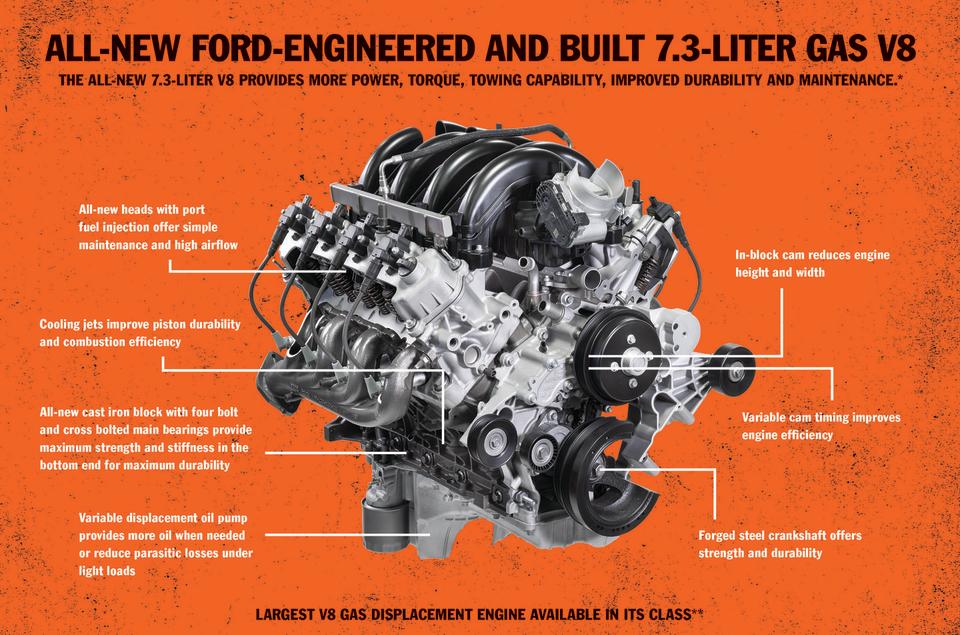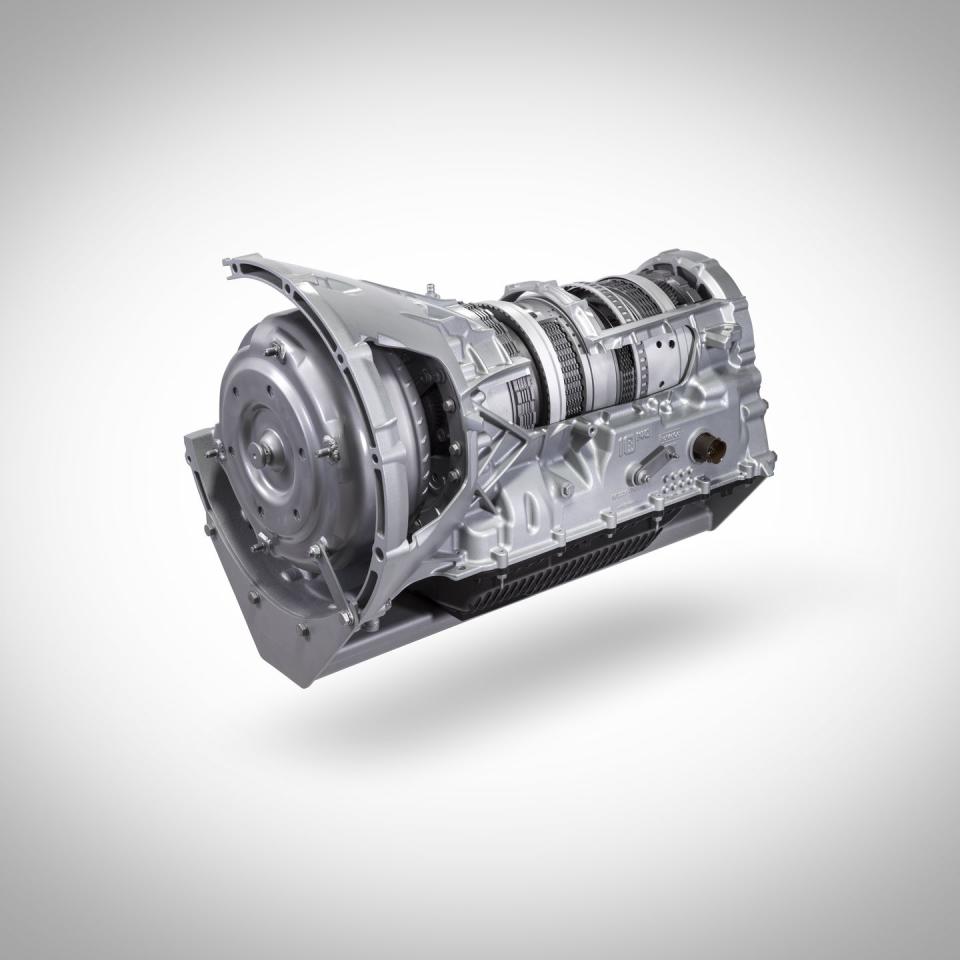Ford Keeps It Old-School With the New 7.3-Liter Gas V8

In an age for which Detroit found a replacement for displacement, Ford built a mammoth. Engines are shrinking, losing cylinders, and gaining turbochargers and superchargers, even as full-size trucks put on weight and grow, grow, grow. Yet an all-new 7.3-liter overhead valve V8 engine is a surprise, especially from Ford.
“As you look inside the engine, most would sum it up as ‘overbuilt’,” says Joel Beltramo, Ford’s manager of large V8 gas engines. Announced for the 2020 Super Duty trucks-medium-duty range from the F-250 through the F-750-the new motor is a throwback in a time in which all the showstopper announcements are about how low-displacement truck motors can be.
Overhead valve (OHV) motors place the camshaft-the brain of the engine-deep inside the engine block. From there it operates pushrods to reach up and work the valves that create the air-fuel mixture that powers the engine. In an overhead cam (OHC) motor, the camshaft is situated atop the engine within the cylinder heads, and they operate the valves more directly by omitting the system of pushrods.

For most of the 20th century, OHV V8s ruled, especially in trucks and especially in America.
Ford put its money on OHC V8s back in the 1990s. General Motors and Chrysler stuck with OHV V8s, but most import automakers’ V8s of the time, car and truck, were single or double overhead cam. Also known as pushrod engines, OHV engines are more compact and cheaper to build, but SOHC and DOHC engines have lower valvetrain mass and so can rev higher than a comparable OHV engine. Without pushrods in the way, an engineer making an OHC engine can also configure its ports for better airflow.
By 2019, most automakers have figured the complications of OHC engines are justified by their benefits, and so the few OHV engines that are still in production tend to be holdovers from the past. But Beltramo says a large-displacement gasoline motor that works for heavier duty trucks is very different than what would be desirable in a lighter-duty F-150. Ford started design work on the 7.3L V8 in 2016, three years after it came to the realization that commercial operators had a wholly unique reference point for what’s considered “good” fuel economy on their medium-duty trucks compared to how they used their lighter-duty trucks.
Fuel economy is always a concern, even for commercial operators, and so Ford wanted the new engine to be OHV so that it would make its power in the lower end of the tachometer. “At lower RPM, the advantage of the stiffer valve train that comes with OHC is much less significant than it is with an engine that uses high RPM to deliver its rated power,” says Beltramo.
Pushrod motors are also narrower than OHC motors, so making the 7.3L an OHV design let Ford engineers fit it into a range of different vehicles with only slight changes for each model. Redesigning or repackaging wiring harnesses and oil dipsticks is a lot easier and cheaper than wedging a thick engine into a range of different truck models would have been.

So what’s different about designing an engine for a working truck that spends most of its life towing or hauling heavy loads compared to an engine for a light-duty truck that spends most of its time hauling nothing? The engineering process to optimize fuel economy for both are surprisingly the same, says Beltramo, but yield surprising conclusions about engine displacement for the trucks that see typically heavy loads.
The F-150’s 2.7L and 3.5L EcoBoost V6s are good motors for a light-duty truck, but put them in a medium-duty role and they’d work too hard, too often to put out their normally impressive fuel economy numbers. They’re also light-duty truck motors built to light-duty specifications, says Beltramo, and their durability would suffer as the high, constant work loads built up too much engine heat. The 7.3L V8 is designed to work harder for longer, the way commercial operators tend to use their Super Duty trucks.
Although the 7.3L V8 is naturally aspirated-meaning that it doesn’t have a supercharger or turbocharger-Ford engineers sourced a lot of experience on the motor’s combustion system from the turbocharged EcoBoost and Power Stroke turbo-diesel projects. On regular-octane fuel, the 7.3L runs a 10.5:1 compression ratio with a conventional port fuel injection system.

“This is a design space where most of our competitors say they need the added cost and complexity of direct injection to operate,” says Beltramo, “but when you think about how many of our vehicles are being used off paved roads or may never even see a paved road again after reaching the work site, robustness to very dirty and harsh environmental situations is an imperative.”
Strength under constant workload meant upgrading many more mundane components that don’t have the cachet of compression ratios and fuel injection systems, but which nonetheless play a crucial role in how a truck engine handles its workload. The 7.3L shares valve seats and piston rings of the same material used on the Power Stroke motors, even though gasoline engine doesn’t see such intense temperatures. As part of the valvetrain, the roller tappet has been upgraded with carbon-nitrided needle bearings and axles for durability’s sake, too.
The 2020 Super Duty will continue to offer the 6.2L SOHC gasoline V8 and the (slightly updated) 6.7L Power Stroke diesel V8 alongside the new 7.3L gas V8 in the Super Duty." Not all engines will be available in all Super Duty models (F-250 through F-750). The 7.3L will also be available in the E-Series full-size van and the F-52 and F-59 stripped chassis trucks.
It’s too early to say if the 7.3L will be the last big gasoline motor Ford ever makes. People would have said five years ago that Ford-or nobody-would go clean-sheet on a new large-displacement gas V8 when the market is downsizing engines everywhere. Last of its kind? Maybe not. But Ford’s 7.3L gas V8 is one of the last.
('You Might Also Like',)

